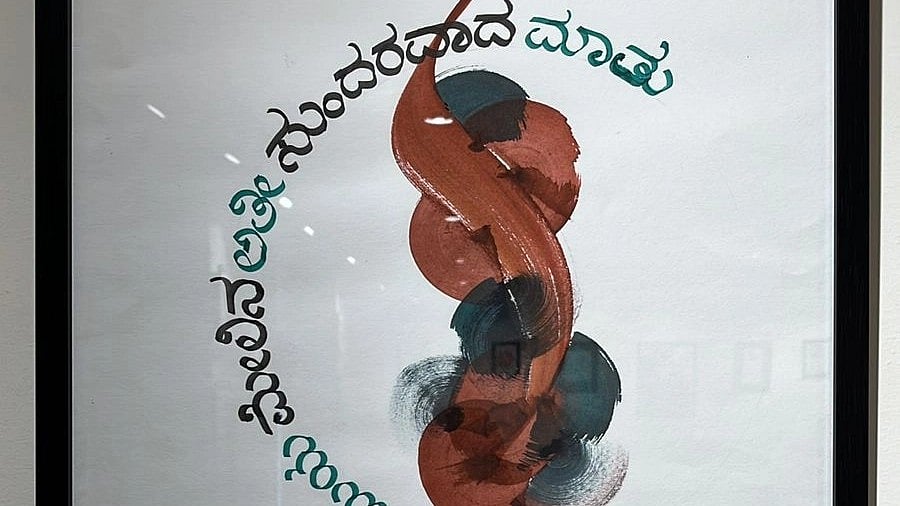
Credit: Special Arrangement
A burning passion for Kannada, a desire for the state to be ranked among the top performers in calligraphy, a social commitment to help young people develop new interests and draw them to learn more about the Kannada script — these combined motives gave birth to 'Akshara Singarotsava 23' — a one-of-its-kind calligraphy exhibit at the Yuvapatha Bengaluru Art Gallery.
Keeping with the spirit of the initiative, the month-long exhibit was inaugurated on November 1, commemorating Karnataka Rajyotsava. The 50-odd paintings being presented, barring the exception of one by Shwetha N, an undergraduate student, are the fruits of a collaboration among five artists — Animesh Naganur, Suresh S Waghmore, T B Kodihalli, Mohankumar Eerappa and G Harikumar.
Waghmore, who teaches Shwetha, says they featured her work to encourage young talent and popularise the art amongst youth.
For the team, all of whom work primarily as designers except Kodihalli, a primary school teacher, the endeavour is a unique attempt to extract the thrill of experimenting with different fonts and trying novel ideas. Interestingly, Harikumar hails from Kerala. He learnt the script for a few weeks before embarking on the creation of his calligraphic works.
Literary legacy
A significant number of the paintings are calligraphic interpretations of poems by famed Kannada writers. A painting by Mohankumar even depicts the Halmidi Shasana, the oldest inscription in Kannada. Notably, the poets chosen as inspiration include a broad spectrum of writers from the Navodaya period (the renaissance period in Kannada literature spanning early-mid 1900s) to Dalit and Bandaya brands of literature.
Featured poets include B M Srikantaiah (B M Sri), Kuvempu, Da Ra Bendre and D V Gundappa from the Navodaya period, litterateurs such as K P Poornachandra Tejaswi from the Navya period and Siddalingaiah from the Dalit period. One or two works are based on the work of Kanakadasa or Sarvajna from the medieval period.
While some works feature on account of their poetic legacy, such as Kuvempu's 'O Nanna Chethana' and D V Gundappa's classic 'Yellarolagondagu Mankuthimma' from 'Mankuthimmana Kagga,' a few are deeply ingrained in the personal experiences and aspirations of the artists.
Dalit identity
Siddalingaiah's iconic 'Nanna Janagalu' from his maiden work 'Holemaadigara Haadu,' particularly stands out — it portrays the trials, tribulations, sufferings and humiliation encountered by the Dalit community for centuries. Waghmore, who worked on the painting inspired by this piece, says it captures the life of the downtrodden in a nutshell. He adds that he has taken some artistic liberties in representing the first stanza in bigger letters while interspersing the lines of the second stanza in between in smaller fonts.
The paintings involve more technical expertise and careful planning than evident on the surface. Animesh says there are challenges galore in Kannada calligraphy, and it is not as easy as English or other languages. "Kannada alphabets are of different sizes unlike English, where all the letters are approximately of the same size except ‘m’ and ‘w’, which are significantly larger. Thus, it is difficult to standardise the letters to one size but we have succeeded in doing so," he adds.
Waghmore says he was inspired by a work by Achyuth Pallav, a Mumbai-based calligrapher. "Calligraphy in Devanagari, Bengali and Malayalam scripts has become very popular, but we are yet to see similar efforts in Kannada, which does not have professional calligraphers. Our initiative is aimed at popularising the art style in Kannada," he says.
Positive response
While a few of the paintings were created specifically for the exhibit, most of them were done earlier. The artists say they are glad to see the positive response of the public and are extremely grateful to Yuvapatha for providing them the gallery space free of cost, for one full month.
Vivek Manganure, who visited the exhibition, says the concept of the exhibit — the fusion of art and literature, fascinated him. "Kannada does not have many fonts like English or Hindi. This initiative helps to expand on that front," he says.
Lauding the attempt, veteran linguist Hampa Nagarajaiah said it was a welcome and laudable development in the days when younger generations are moving away from Kannada towards English. However, he commented on the attempt's practicality, stating that most Kannada speakers do not really know how to read it. "The connection between the script and the dialect is an accidental one," Nagarajaiah points out.
Credit: Special Arrangement
Credit: Special Arrangement
Credit: Special Arrangement
Credit: Special Arrangement
Credit: Special Arrangement
Credit: Special Arrangement